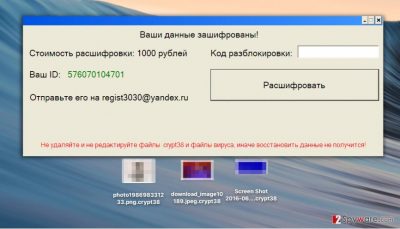Crypt38 ransomware / virus (Easy Removal Guide)
Crypt38 virus Removal Guide
What is Crypt38 ransomware virus?
Description of Crypt38 ransomware
If your PC has been infected with Crypt38 virus, you should not lose your hope to access your files again. It seems that it is not as dangerous as other ransomware variants since this malware is built in a really simple way. It uses a symmetric encryption algorithm, which means that it uses the same key to encrypt and to decrypt victim’s data. So when it infiltrates a computer, it starts encrypting files and appending .crypt38 file extensions to them, and then it displays a message written in Russian language, saying that all files have been locked, and in order to recover them, the user must pay 1000 rubles. If we look back at other variants of ransomware, the ransom that Crypt38 malware demands is surprisingly small – it is approximately 15 USD. The problem is that the authors of this computer virus didn’t seem to bother themselves by creating an advanced encryption algorithm.

As we have already mentioned, it uses the same key to decrypt files, and this key is calculated from victim’s ID, which is revealed in the same message that virus displays. Cyber criminals ask the victim to send this ID to them via email and wait for instructions on how to buy a decryption key. However, since computer security experts have managed to sort out what algorithm is used to calculate the encryption key, victims can now get the decryption key for free with a help of this Crypt38 decryption key generator. Before you use it, you must eliminate this malware from your PC, and for that, you should use a reliable anti-malware software like FortectIntego. We also suggest creating a backup before you try to decrypt your files using this tool.
How did this malware enter your PC?
It is unknown what particular methods the authors of this ransomware use to distribute this amateurish virus, but it seems that they use basic techniques that are well-known to all security researchers. Malware is often added to spam emails, so naturally, you should not open any suspicious email attachments, especially those that come from unknown sources. If you do not know the sender of the letter in person, or if sender’s email address raises even the slightest suspicion to you, do not open such email, nor links or attachments it includes.
It is also important to keep all your software up-to-date. Cyber criminals often exploit vulnerabilities of outdated software and use them to infect computers with malware. Additionally, this ransomware can land on your computer in case you enjoy clicking on links, intrusive ads, and basically exploring various Internet content before checking its reliability. If you think that you cannot give up such habits, then we recommend you to protect your data by creating backups and installing the anti-malware software on your computer.
How to remove Crypt38 virus from your computer?
Crypt38 ransomware is an unprofessionally made computer threat, therefore, if you have been infected with it, you should not pay the ransom, no matter that the cost of it is quite ridiculous. We recommend you to remove this virus immediately as by being in your computer system it makes it vulnerable to other computer infections. This virus is no regular program, and it is extremely hard to remove it, so you should not attempt to delete its files manually. Crypt38 removal should be completed with a help of the anti-malware program, as it can detect and eliminate every single component of it. Besides, such program can clean your PC from other threats and spyware-type programs automatically, so you will not have to waste your time trying to identify and eliminate them manually.
Getting rid of Crypt38 virus. Follow these steps
Manual removal using Safe Mode
Important! →
Manual removal guide might be too complicated for regular computer users. It requires advanced IT knowledge to be performed correctly (if vital system files are removed or damaged, it might result in full Windows compromise), and it also might take hours to complete. Therefore, we highly advise using the automatic method provided above instead.
Step 1. Access Safe Mode with Networking
Manual malware removal should be best performed in the Safe Mode environment.
Windows 7 / Vista / XP
- Click Start > Shutdown > Restart > OK.
- When your computer becomes active, start pressing F8 button (if that does not work, try F2, F12, Del, etc. – it all depends on your motherboard model) multiple times until you see the Advanced Boot Options window.
- Select Safe Mode with Networking from the list.

Windows 10 / Windows 8
- Right-click on Start button and select Settings.

- Scroll down to pick Update & Security.

- On the left side of the window, pick Recovery.
- Now scroll down to find Advanced Startup section.
- Click Restart now.

- Select Troubleshoot.

- Go to Advanced options.

- Select Startup Settings.

- Press Restart.
- Now press 5 or click 5) Enable Safe Mode with Networking.

Step 2. Shut down suspicious processes
Windows Task Manager is a useful tool that shows all the processes running in the background. If malware is running a process, you need to shut it down:
- Press Ctrl + Shift + Esc on your keyboard to open Windows Task Manager.
- Click on More details.

- Scroll down to Background processes section, and look for anything suspicious.
- Right-click and select Open file location.

- Go back to the process, right-click and pick End Task.

- Delete the contents of the malicious folder.
Step 3. Check program Startup
- Press Ctrl + Shift + Esc on your keyboard to open Windows Task Manager.
- Go to Startup tab.
- Right-click on the suspicious program and pick Disable.

Step 4. Delete virus files
Malware-related files can be found in various places within your computer. Here are instructions that could help you find them:
- Type in Disk Cleanup in Windows search and press Enter.

- Select the drive you want to clean (C: is your main drive by default and is likely to be the one that has malicious files in).
- Scroll through the Files to delete list and select the following:
Temporary Internet Files
Downloads
Recycle Bin
Temporary files - Pick Clean up system files.

- You can also look for other malicious files hidden in the following folders (type these entries in Windows Search and press Enter):
%AppData%
%LocalAppData%
%ProgramData%
%WinDir%
After you are finished, reboot the PC in normal mode.
Remove Crypt38 using System Restore
-
Step 1: Reboot your computer to Safe Mode with Command Prompt
Windows 7 / Vista / XP- Click Start → Shutdown → Restart → OK.
- When your computer becomes active, start pressing F8 multiple times until you see the Advanced Boot Options window.
-
Select Command Prompt from the list

Windows 10 / Windows 8- Press the Power button at the Windows login screen. Now press and hold Shift, which is on your keyboard, and click Restart..
- Now select Troubleshoot → Advanced options → Startup Settings and finally press Restart.
-
Once your computer becomes active, select Enable Safe Mode with Command Prompt in Startup Settings window.

-
Step 2: Restore your system files and settings
-
Once the Command Prompt window shows up, enter cd restore and click Enter.

-
Now type rstrui.exe and press Enter again..

-
When a new window shows up, click Next and select your restore point that is prior the infiltration of Crypt38. After doing that, click Next.


-
Now click Yes to start system restore.

-
Once the Command Prompt window shows up, enter cd restore and click Enter.
Finally, you should always think about the protection of crypto-ransomwares. In order to protect your computer from Crypt38 and other ransomwares, use a reputable anti-spyware, such as FortectIntego, SpyHunter 5Combo Cleaner or Malwarebytes
How to prevent from getting ransomware
Do not let government spy on you
The government has many issues in regards to tracking users' data and spying on citizens, so you should take this into consideration and learn more about shady information gathering practices. Avoid any unwanted government tracking or spying by going totally anonymous on the internet.
You can choose a different location when you go online and access any material you want without particular content restrictions. You can easily enjoy internet connection without any risks of being hacked by using Private Internet Access VPN.
Control the information that can be accessed by government any other unwanted party and surf online without being spied on. Even if you are not involved in illegal activities or trust your selection of services, platforms, be suspicious for your own security and take precautionary measures by using the VPN service.
Backup files for the later use, in case of the malware attack
Computer users can suffer from data losses due to cyber infections or their own faulty doings. Ransomware can encrypt and hold files hostage, while unforeseen power cuts might cause a loss of important documents. If you have proper up-to-date backups, you can easily recover after such an incident and get back to work. It is also equally important to update backups on a regular basis so that the newest information remains intact – you can set this process to be performed automatically.
When you have the previous version of every important document or project you can avoid frustration and breakdowns. It comes in handy when malware strikes out of nowhere. Use Data Recovery Pro for the data restoration process.





















